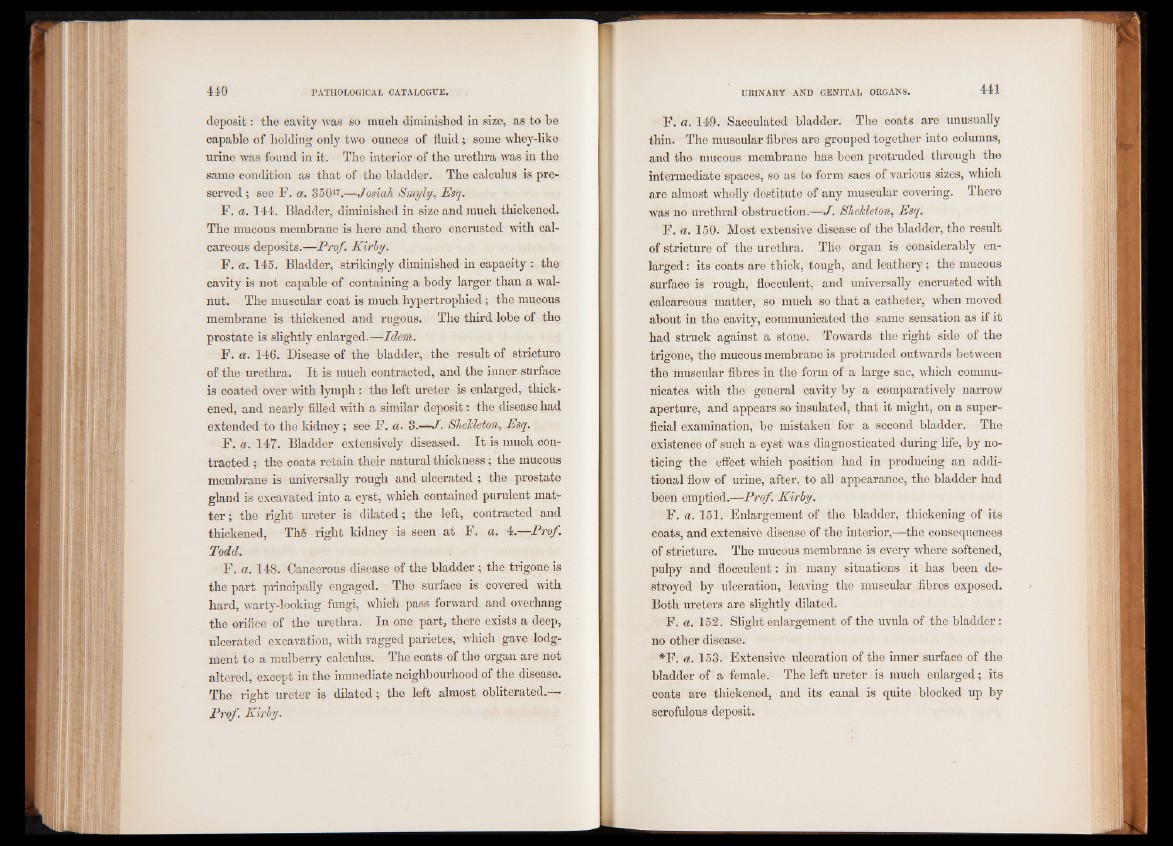
deposit: the cavity was so much diminished in size, as to be
capable of holding only two ounces of fluid; some whey-like
urine was found in it. The interior of the urethra was in the
same condition as that of the bladder. The calculus is preserved
; see F. a. 35017.—Josiah Smyly, Esq.
F. a. 144. Bladder, diminished in size and much thickened.
The mucous membrane is here and there encrusted with calcareous
deposits.—Prof. Kirby.
F. a. 145. Bladder, strikingly diminished in capacity : the
cavity is not capable of containing a body larger than a walnut.
The muscular coat is much hypertrophied; the mucous
membrane is thickened and rugous. The third lobe of the
prostate is slightly enlarged.—Idem.
F. a. 146. Disease of the bladder, the result of stricture
of the urethra. It is much contracted, and the inner surface
is coated over with lymph : the left ureter is enlarged, thickened,
and nearly filled with a similar deposit: the disease had
extended to the kidney; see F. a. 3.—J. SheMeton, Esq.
F. a. 147. Bladder extensively diseased. It is much contracted
; the coats retain their natural thickness; the mucous
membrane is universally rough and ulcerated ; the prostate
gland is excavated into a cyst, which contained purulent matter;
the right ureter is dilated; the left, contracted and
thickened, Th§ right kidney is seen at F. a. 4.—Prof.
Todd.
F. a. 148. Cancerous disease of the bladder ; the trigone is
the part principally engaged. The surface is covered with
hard, warty-looking fungi, which pass forward and overhang
the orifice of the urethra. In one part, there exists a deep,
ulcerated excavation, with ragged parietes, which gave lodgment
to a mulberry calculus. The coats of the organ are not
altered, except in the immediate neighbourhood of the disease.
The right ureter is dilated; the left almost obliterated.—
Prof. Kirby.
F. a. 149. Sacculated bladder. The coats are unusually
thin. The muscular fibres are grouped together into columns,
and the mucous membrane has been protruded through the
intermediate spaces, so as to form sacs of various sizes, which
are almost wholly destitute of any muscular covering. There
was no urethral obstruction.—J. SheMeton, Esq.
F. a. 150. Most extensive disease of the bladder, the result
of stricture of the urethra. The organ is considerably enlarged
: its coats are thick, tough, and leathery; the mucous
surface is rough, flocculent, and universally encrusted with
calcareous matter, so much so that a catheter, when moved
about in the cavity, communicated the same sensation as if it
had struck against a stone. Towards the right side of the
trigone, the mucous membrane is protruded outwards between
the muscular fibres in the form of a large sac, which communicates
with the general cavity by a comparatively narrow
aperture, and appears so insulated, that it might, on a superficial
examination, be mistaken for a second bladder. The
existence of such a cyst was diagnosticated during life, by noticing
the effect which position had in producing an additional
flow of urine, after, to all appearance, the bladder had
been emptied.—Prof. Kirby.
F. a. 151. Enlargement of the bladder, thickening of its
coats, and extensive disease of the interior,—the consequences
of stricture. The mucous membrane is every where softened,
pulpy and flocculent: in many situations it has been destroyed
by ulceration, leaving the muscular fibres exposed.
Both ureters are slightly dilated.
F. a. 152. Slight enlargement of the uvula of the bladder:
no other disease.
*F. a. 153. Extensive ulceration of the inner surface of the
bladder of a female. The left ureter is much enlarged; its
coats are thickened, and its canal is quite blocked up by
scrofulous deposit.